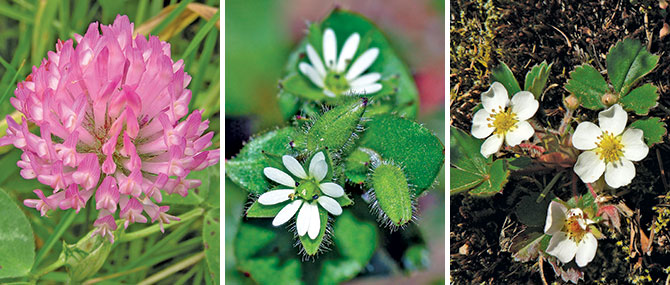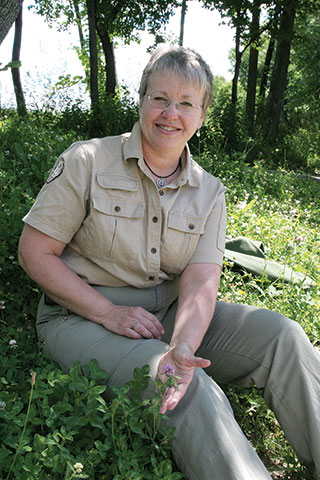A Wild Cup Of Tea
by Sarah Quintal

Wild herbs and flowers in your own backyard can be healthful and delicious
There are plenty of plants growing in your yard and around vegetable and flower beds that have loads of therapeutic value that we perhaps too infrequently take advantage of. And why not? They’re wild, pervasive, delicious, and free for the taking. Many of them flourish anywhere there’s a piece of earth exposed enough to produce life. I’d like to focus on a few that are easy to identify, make tasty, healthful teas, and are everywhere right now: red clover, chickweed, and wild strawberry.
Red clover (Trifolium pratense) is a pretty, pink perennial field herb that you can find almost anywhere that isn’t too regularly or too closely mowed. Harvest the flowers when they are pink to red and in full bloom. The flowers are high in calcium, iron, and nitrogen. You can eat them raw (a beautiful addition to a summer salad) or dry the flowers in a semi-shaded place and make an antioxidant-rich tea. Bradford Angier’s Field Guide to Medicinal Wild Plants says the tea has been traditionally used to “improve sluggish appetites, regulate digestive functions, and to treat liver ailments.” Store the dried flowers in a paper bag in a dark place.
Farmers and gardeners tend to detest chickweed (Stellaria media) because it grows so well in vegetable and perennial gardens, but I love it. First off, if you don’t want it, it’s the easiest weed to pull, and if you do want it, you can do a lot with it. Chickweed is a leggy, creeping plant with tiny white, star-shaped flowers. It’s high in calcium, magnesium, potassium, and vitamin C. You can eat it raw as an addition to salads, or cooked like spinach. The tea is a mild diuretic, and soothes coughs and the digestive system. Euell Gibbons says old wives tales suggest it prevents obesity by curbing hunger. You can also make a stronger tea, cool it down, and use it as a skin wash to sooth minor skin irritations and itches.
Wild strawberry (Fragaria virginiana) is all over the place in lawns and fields, and it’s not just the tiny red fruits that are pleasing to the taste buds but the leaves as well. Steep the leaves, fresh or dried, (and berries, if you can find some) for a sweet, delicious treat. The tea has medicinal properties that herbalists suggest benefit the female reproductive processes and is known to remedy nausea and diarrhea. Externally, as a tea wash, it’s been used to treat eczema because of its high vitamin C content.
Making herbal tea
There are a few ways to make herbal teas. If you’re interested most in flavor, and don’t care too much about getting the healthful benefits of the plant, just steep one teaspoon herb to one cup boiling water for one to five minutes. If you want the therapeutic affects, use a higher ratio of tea to water and steep five minutes or more. The taste will be much stronger, and may become bitter, so make sure to keep a jar of honey nearby. Try each herb by itself and then mix and match. I like to add mint to my backyard teas, especially red clover. You might also want to turn the tea into popsicles for your kids.
Harvest tips

Earth Spirit Education Services naturalist Mary Jo Graham says before you harvest anything, you must remember to be a responsible forager. Don’t be greedy. Never take more than one third of a plant grouping so the wild herbs will still reproduce.
Next, you’ve got to go through what Graham calls the six “knows” of harvesting wild plants. We’ve picked some of the easier ones to use and identify, but it’s still important to go through this process.
1. Know the species: Make sure to use field guides and scientific names for proper identification.
2. Know the environment: Did there used to be an asbestos-laden house in the vacant lot where you’re picking flowers? Are you in a spot that could be contaminated by road or industry run-off? Are you in the dog park? All bad locations.
3. Know when to harvest: The beneficial properties of the herb may be best at a certain period in the growing cycle or certain time of year. Some plants, like milkweed, can become toxic after a certain point.
4. Know the plant’s purpose: What’s going to happen to you when you eat it or drink it? Is it a stimulant and you’ve already had five cups of coffee? Might be a bit much. Is it a strong diuretic? Could it interact adversely with medications? Look into it.
5. Know which part(s) to use: Would you eat the leaf part of a carrot? Common sense, right? Well, not with new herbs. Always check.
6. Know how to prepare the plant.
Resources
Stalking the Healthful Herbs by Euell Gibbons
Peterson Field Guides: Eastern/Central Medicinal Plants and Herbs
Herbs: Partners in Life by Adele Dawson
Family Herbal: A Guide to Living Life with Energy, Health, and Vitality by Rosemary Gladstar
Also make sure to take a peek at Earth Spirit’s website every now and then: earthspiritedu.org. They do fascinating wild edible walks several times a year at varying locations.
blog comments powered by Disqus|
Issue Navigation> Issue Index > v9n26 (Summer Food Issue: week of Thursday, July 1) > A Wild Cup Of Tea This Week's Issue • Artvoice Daily • Artvoice TV • Events Calendar • Classifieds |









 Current Issue
Current Issue